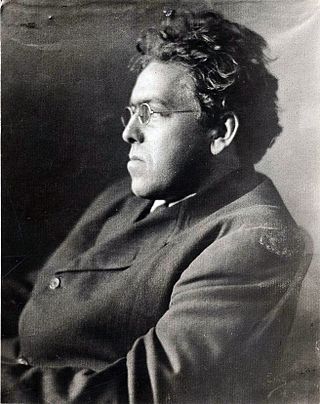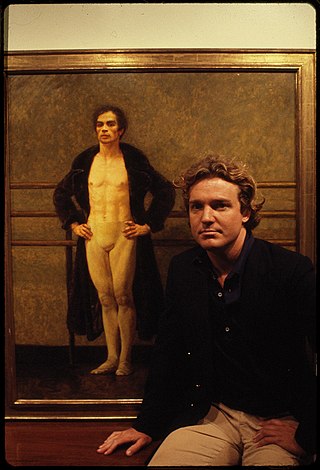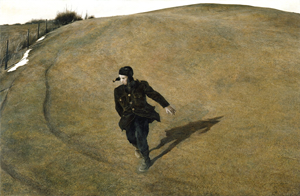
Charles Henry Buckius Demuth was an American painter who specialized in watercolors and turned to oils late in his career, developing a style of painting known as Precisionism.

Peter Hurd was an American painter whose work is strongly associated with the people and landscapes of San Patricio, New Mexico, where he lived from the 1930s. He is equally acclaimed for his portraits and his western landscapes.
Henriette Wyeth Hurd was an American artist noted for her portraits and still life paintings. The eldest daughter of illustrator N.C. Wyeth, she studied painting with her father and brother Andrew Wyeth at their home and studio in Chadds Ford, Pennsylvania.

Andrew Newell Wyeth was an American visual artist, primarily a realist painter, working predominantly in a regionalist style. He was one of the best-known U.S. artists of the middle 20th century.

Newell Convers Wyeth, known as N. C. Wyeth, was an American painter and illustrator. He was the pupil of Howard Pyle and became one of America's most well-known illustrators. Wyeth created more than 3,000 paintings and illustrated 112 books — 25 of them for Scribner's, the Scribner Classics, which is the body of work for which he is best known. The first of these, Treasure Island, was one of his masterpieces and the proceeds paid for his studio. Wyeth was a realist painter at a time when the camera and photography began to compete with his craft. Sometimes seen as melodramatic, his illustrations were designed to be understood quickly. Wyeth, who was both a painter and an illustrator, understood the difference, and said in 1908, "Painting and illustration cannot be mixed—one cannot merge from one into the other."

Robert Indiana was an American artist associated with the pop art movement.

James Browning Wyeth is an American realist painter, son of Andrew Wyeth, and grandson of N.C. Wyeth. He was raised in Chadds Ford Township, Pennsylvania, and is artistic heir to the Brandywine School tradition — painters who worked in the rural Brandywine River area of Delaware and Pennsylvania, portraying its people, animals, and landscape.
Philip Martin Pearlstein was an American painter best known for Modernist Realist nudes. Cited by critics as the preeminent figure painter of the 1960s to 2000s, he led a revival in realist art.

American Regionalism is an American realist modern art movement that included paintings, murals, lithographs, and illustrations depicting realistic scenes of rural and small-town America primarily in the Midwest. It arose in the 1930s as a response to the Great Depression, and ended in the 1940s due to the end of World War II and a lack of development within the movement. It reached its height of popularity from 1930 to 1935, as it was widely appreciated for its reassuring images of the American heartland during the Great Depression. Despite major stylistic differences between specific artists, Regionalist art in general was in a relatively conservative and traditionalist style that appealed to popular American sensibilities, while strictly opposing the perceived domination of French art.
John Willard McCoy (1910–1989) was an American artist who painted landscapes, portraits, and still lifes. He was married to Ann Wyeth, daughter of N.C. Wyeth and sister of Andrew Wyeth, all artists.

Joseph Hirsch (1910–1981) was an American painter, illustrator, muralist and teacher. Social commentary was the backbone of Hirsch's art, especially works depicting civic corruption and racial injustice.
George Alexis Weymouth, better known as Frolic Weymouth, was an American artist, whip or stager, and conservationist. He served on the United States Commission of Fine Arts in the 1970s and was a member of the Du Pont family.
Carolyn Wyeth, daughter of N.C. Wyeth and sister of Andrew Wyeth, was a well-known artist in her own right. Her hometown was Chadds Ford, Pennsylvania. She worked and taught out of N. C. Wyeth House and Studio. Her nephew, Jamie Wyeth was one of her students.

The Kuerner Farm, also known as Ring Farm, is an historic farm which is located in Chadds Ford, Pennsylvania. It is notable for its association with artist Andrew Wyeth, who created about one-third of his work, more than 1,000 paintings and drawings, on subjects he found there during a span of seventy-seven years.

Olson House is a 14-room Colonial farmhouse in Cushing, Maine. The house was made famous by its depiction in Andrew Wyeth's Christina's World. The house and its occupants, Christina and Alvaro Olson, were depicted in numerous paintings and sketches by Wyeth from 1939 to 1968. The house was designated as a National Historic Landmark in June 2011. The Farnsworth Art Museum owns the house; it is open to the public.
Walter Henry "Jack" Beal Jr. was an American realist painter.

Winter 1946 is a 1946 painting by the American artist Andrew Wyeth. It depicts a boy running down a hill in the winter.

Public Sale is a 1943 painting by the American artist Andrew Wyeth. It shows two men by a car and in the distance a crowd of people outside a farm building. The event depicted is the forced auction of a farm after the farmer's wife had died.

Andrew Spence is an American artist known for abstract paintings that combine a minimalist vocabulary with playful references to the observed world. In the 1970s and 1980s, he gained recognition as one of a number of younger artists who were re-examining geometric modernism through a contemporary lens that invited humor and reference to everyday objects and life experience into the tradition. Spence's method of distilling visual phenomena into simple, emblematic images has been compared to Ellsworth Kelly, but his work has differed in its more even balance between abstraction and recognition, intuitive approach, and varied, expressive paint surfaces. Art in America critic Ken Johnson wrote that his work maintains "an ironic tension between lofty purism of modernist geometry and earth-bound ordinariness of the vernacular sources." In later paintings, Spence has increasingly obscured the original inspirations of his abstractions, in both form and titling. His work belongs to the permanent collections of the Metropolitan Museum of Art, Museum of Modern Art, and Whitney Museum of American Art, among others. He has received a Guggenheim Fellowship and awards from the American Academy of Arts and Letters and National Endowment for the Arts.
Barclay Lawrence Rubincam was an American artist who painted mostly in a regionalist style. He specialized in natural and historical scenes of his native Chester County, Pennsylvania. His art is held in the permanent collections of the Pennsylvania Museum of Art, the Brandywine Museum of Art, and the Chester County History Center.













